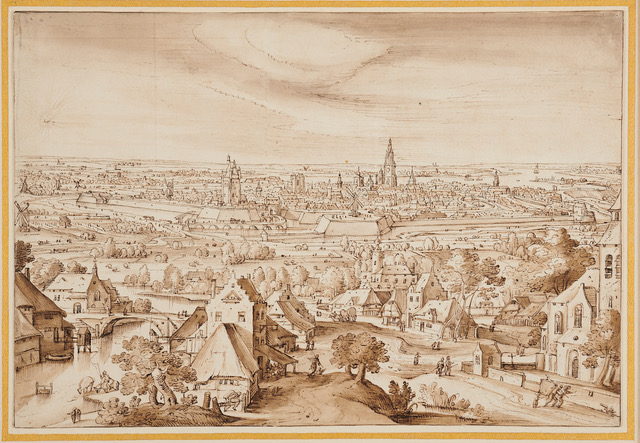It seems incredible that at least 30 drawings in The Ashmolean’s new spring exhibition Bruegel to Rubens – Great Flemish Drawings will be on display for the first time ever.
‘It really is a once-in-a-lifetime opportunity to get close to these delicate and rarely displayed works by famous Flemish masters’
The delicacy of their form means they can rarely be taken out of their specialised storage units, but for 12 weeks only, you can see 120 of these 16th and 17th century pieces by the Flemish masters, for yourselves, many of which have protected status.

For An Van Camp, curator of Northern European Art at The Ashmolean, it is “a dream come true to share these precious drawings with the general public, specialists, and drawing practitioners.”
Hailing from Antwerp herself only makes the exhibition more personal and prescient. And so An set out to make the Bruegel to Rubens exhibition as accessible as possible.

“Some people consider drawings to be hard to interpret or too sophisticated, but really it’s like looking over the artist’s shoulder and a much more intimate way of getting to know them,” she says. “So we include sketches that artists made when looking out of the window or just drawing what they see, early drawings of pets and animals, nature, things drawn on a whim.
“It’s like looking over the artist’s shoulder and a much more intimate way of getting to know them’
“Whilst other drawings are made as independent works – stand alone pieces to be sold or given away, often as friendship tokens, and they are little gems, very finely created and intricate. And yes, they require more attention than perhaps bigger paintings, but that’s what makes them so special,” An explains.

There are also a series of preliminary drawings for bigger works including sketches by print-makers, silversmiths, sculptors, architects and glassmakers, as well as painters: “All artists needed to learn the art of drawing before they could take their work any further, and this is a way of emphasising that,” An says.
‘to share these hidden treasures and finally bring them to light is so special’
Another highlight are the incredibly detailed drawings needed for tapestries. “I am so proud of this part of the exhibition because these sketches had to be incredibly exact because they would be directly copied by the tapestry makers, like a template, so to share these hidden treasures and finally bring them to light is so special,” An adds.
Choosing with pieces to put on display however was her first problem, and it’s taken her two years to collate the collection that will be shown from Saturday.

The Bruegel to Rubens exhibition is the result of an astonishing collaboration between UNESCO World Heritage Site, the Museum Plantin-Moretus in Antwerp and The Ashmolean. The Antwerp museum is set on the site of the original 16th century residence and workshops of the Plantin and Moretus publishing dynasty where the oldest printing presses in the world can be found, alongside many of their print studies.
you’ll need to be quick, because come June 23, all 120 drawings will be returned to their carefully monitored storage facilities for preservation purposes
The Museum Plantin-Moretus in Antwerp ran their own exhibition in November, but now half of it has winged its way over to Oxford to join the extensive Ashmolean collection and works from The Bodleian and Christ Church Picture Gallery, alongside pieces from private lenders. So why is Oxford so rich in Flemish drawings?

“Because they were widely collected in the 18th and 19th centuries by the likes of Francis Douce, Chambers Hall and General Guise, and many of these collections were left to the university,” An explains.
Which is why we will be able to delve into such an extensive gathering of work by Pieter Bruegel the Elder, Peter Paul Rubens and Anthony Van Dyck, amongst many others in Bruegel to Rubens.
But you’ll need to be quick, because come June 23, all 120 drawings will be returned to their carefully monitored storage facilities for preservation purposes.

“Just to display them here for 12 weeks, which is the maximum amount of time they can be exposed, means that the lighting and humidity levels have had to be carefully designed at The Ashmolean because the drawings are so fragile – they are made of paper and vellum rather than canvas, so there are really strict guidelines around displaying them,” Ana explains.
‘it’s so rare for these amazing drawings to be seen in public’
So is Ana nervous about the public opening of the exhibition on Saturday? “To juxtapose the collections from Antwerp and Oxford has been so exciting, but more than that it’s so rare for these amazing drawings to be seen in public. So I hope that by showing them anew more people can grow to know these artists. It’s been quite a daunting project, but one I’m very proud of.

“It really is a once-in-a-lifetime opportunity to get close to these delicate and rarely displayed works by famous Flemish masters, as well as those by lesser-known artists who deserve a wider audience.”
Bruegel To Rubens, Great Flemish Drawings runs from March 23 June 23 at The Ashmolean. BOOK HERE with numerous associated workshops, talks, tours, both online and in person, taking place.
FULL REVIEW TO FOLLOW















